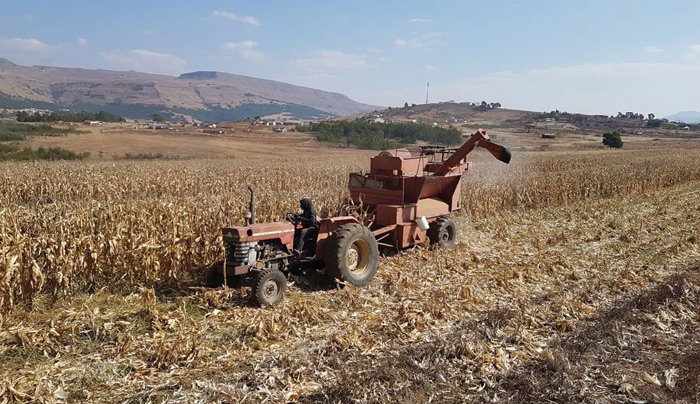July 2021
| RICHARD MCPHERSON, AGRIBUSINESS AND PROJECT MANAGEMENT CONSULTANT |  |
Timely harvesting will ensure that the potential maximum yield and income of the crops can be fully realised as soon as possible after the stage of physiological maturity has been reached.
The harvesting of maize, sunflowers and soybeans involves the consideration of some of the same factors common to each crop.
CONSIDERATIONS FOR MAIZE
The whole plant and various leaf growth stages can be described from planting to tasselling or silking. The number of days for each phase differs for each cultivar. The reproductive phases cover pollination, seed or kernel development, grain filling as nutrients are transported to the cob and physiological maturity as well as the end of growth for the maximum size and weight of each seed. This phase can take about 63 days for a total of 119 days from seedling emergence to physiological maturity.
Physiological maturity is defined as the moment that the plant and seed will no longer grow or increase in weight. The mature plant and seed will then begin to dry off until harvesting occurs. The time period depends on cultivars planted, growth or heat units received, and general weather conditions including rainfall, onset of the first frosts and humidity of the air during this period.
The plant indicator for physiological maturity is found by examining the seed to find a black kernel layer formation at the base of the kernel. This can be seen by splitting the seed from top to bottom with a sharp knife to look for the black line formation.
It is important to walk through the lands and take note of when this stage has been reached. The percentage (%) moisture content of the seed can be monitored by taking samples of cobs, removing the kernels and having them tested at your local silo or using your own tester. The rate of moisture loss from the kernels can be measured and so monitored as it falls from about 35% to 14% during the next 40 days or more.
The planning date for combining can then be estimated to ensure that your own combine is ready for the harvesting operation, or that you have notified a contractor as to the areas and possible dates for the commencement of harvesting.
If you farm in an area of high humidity, planning must be done if you plan for the crop to be dried on the farm (if you have enough floor space available), or commercially when you deliver to a registered silo.
Otherwise, combining must be delayed until the crop is below 14% moisture. It can take another three weeks or more to drop from 18% to below 14%. Some silos will dry the maize seed below 14% if the temperatures will exceed 30°C during the estimated storage period.
If you have suitable cribs or other facilities the cobs can be harvested at 18% moisture and stored to be milled and used later. However, if the cobs do not have enough airflow through the storage area in high humidity areas, the danger of aflatoxin infection in the cobs will be highly increased.
CONSIDERATIONS FOR SUNFLOWERS
The vegetative stages, with the number of leaves formed as a guide, can take place over 35 days or more from planting. This includes germination, seed establishment and early leaf development. The leaves will continue to grow and develop. Unlike maize, the bud formation occurs early on and the whole plant with stem, leaves and flowering head continue and is known as the flowering bud stage. Additional phases are flowering and seed development.
Physiological maturity is then reached with the head going from green to yellow and then brown. A total of about 155 days from planting to physical maturity is usually required. Physiological maturity is identified when the bracts surrounding the sunflower head change to brown with the moisture percentage still being at about 30% to 40 %.
The ideal time to start harvesting is before the heads are totally dry when the seed is about 9% to 10% moisture. At 7% moisture the shattering losses can be high. The seed moisture percentage must be closely monitored so that the crop can be harvested as soon as possible.
Uncleaned and newly combined seed can have fungus developing within 24 hours if the seed is above 9% moisture and the harvested seed is just offloaded onto a shed floor.
CONSIDERATIONS FOR SOYBEANS
The growth phases for soybeans go through emergence to the fifth open leaf stage. The reproductive phase begins with the start of pod formation and ends with the drying of the plants, pods and seeds. At physical maturity 95% of the pods have become yellow brownish, tan or tawny pod colour.
Another five to ten days of drying weather are required after physiological maturity for the average moisture levels of the beans to be less than 15%. Harvesting and storage can be started when the seeds are at an ideal 13% moisture.
Soybeans can be of determinate or indeterminate growth habits. The determinate plants stop growing and flowering when a certain reduced daylight length occurs. The plants therefore reach a maximum size with pods that mature over a short period. Indeterminate soybean cultivars continue to grow, flower and produce pods until triggered to stop by a certain genetically determined shortening daylight length period.
Up to 75% of all flowers created may abort before pod setting starts.
The plants can have a range of from emergence of 43 to 65 days to 50% flowering with a range of 127 to 143 days to harvest maturity. Long season cultivars planted in September or October can take ten to 14 days or more to emerge if a cold spell is experienced. Experience has shown that soybeans can ‘hold back’ in a dry period during the flowering period.
It is critical to continuously monitor the moisture percentage from when the seeds reach their minimum size and rapidly start to lose moisture. A combine must be available a least a week before the optimum harvesting moisture of 13% might be reached. If the pods are too dry more than 15% to 20% of a crop can be lost due to pre-combining shattering and the harvesting process itself.
CONCLUSION
When deciding on maize, sunflower or soybean cultivars make sure you know the estimated number of days for the vegetative and reproductive periods. Physical maturity and the ideal harvesting moisture percentages can then be closely monitored.

A timely harvest is important to avoid losses and will further help to maximize potential grain yield.
Publication: July 2021
Section: Pula/Imvula